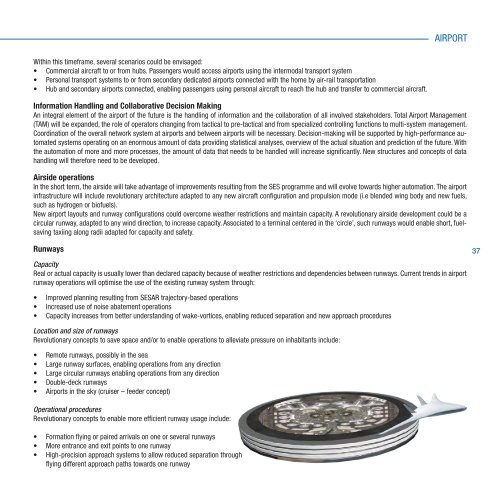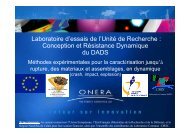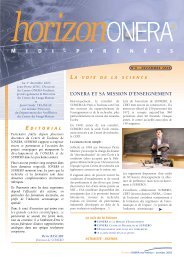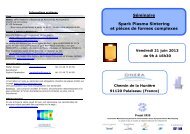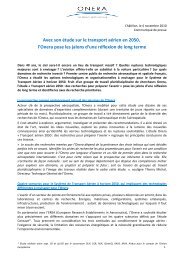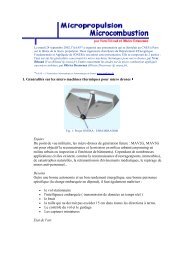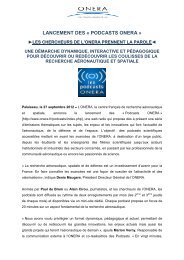From Air Transport System 2050 Vision to Planning for ... - Onera
From Air Transport System 2050 Vision to Planning for ... - Onera
From Air Transport System 2050 Vision to Planning for ... - Onera
Create successful ePaper yourself
Turn your PDF publications into a flip-book with our unique Google optimized e-Paper software.
AIRPORT<br />
Within this timeframe, several scenarios could be envisaged:<br />
• Commercial aircraft <strong>to</strong> or from hubs. Passengers would access airports using the intermodal transport system<br />
• Personal transport systems <strong>to</strong> or from secondary dedicated airports connected with the home by air-rail transportation<br />
• Hub and secondary airports connected, enabling passengers using personal aircraft <strong>to</strong> reach the hub and transfer <strong>to</strong> commercial aircraft.<br />
In<strong>for</strong>mation Handling and Collaborative Decision Making<br />
An integral element of the airport of the future is the handling of in<strong>for</strong>mation and the collaboration of all involved stakeholders. Total <strong>Air</strong>port Management<br />
(TAM) will be expanded, the role of opera<strong>to</strong>rs changing from tactical <strong>to</strong> pre-tactical and from specialized controlling functions <strong>to</strong> multi-system management.<br />
Coordination of the overall network system at airports and between airports will be necessary. Decision-making will be supported by high-per<strong>for</strong>mance au<strong>to</strong>mated<br />
systems operating on an enormous amount of data providing statistical analyses, overview of the actual situation and prediction of the future. With<br />
the au<strong>to</strong>mation of more and more processes, the amount of data that needs <strong>to</strong> be handled will increase significantly. New structures and concepts of data<br />
handling will there<strong>for</strong>e need <strong>to</strong> be developed.<br />
<strong>Air</strong>side operations<br />
In the short term, the airside will take advantage of improvements resulting from the SES programme and will evolve <strong>to</strong>wards higher au<strong>to</strong>mation. The airport<br />
infrastructure will include revolutionary architecture adapted <strong>to</strong> any new aircraft configuration and propulsion mode (i.e blended wing body and new fuels,<br />
such as hydrogen or biofuels).<br />
New airport layouts and runway configurations could overcome weather restrictions and maintain capacity. A revolutionary airside development could be a<br />
circular runway, adapted <strong>to</strong> any wind direction, <strong>to</strong> increase capacity. Associated <strong>to</strong> a terminal centered in the ‘circle’, such runways would enable short, fuelsaving<br />
taxiing along radii adapted <strong>for</strong> capacity and safety.<br />
Runways<br />
Capacity<br />
Real or actual capacity is usually lower than declared capacity because of weather restrictions and dependencies between runways. Current trends in airport<br />
runway operations will optimise the use of the existing runway system through:<br />
• Improved planning resulting from SESAR trajec<strong>to</strong>ry-based operations<br />
• Increased use of noise abatement operations<br />
• Capacity increases from better understanding of wake-vortices, enabling reduced separation and new approach procedures<br />
Location and size of runways<br />
Revolutionary concepts <strong>to</strong> save space and/or <strong>to</strong> enable operations <strong>to</strong> alleviate pressure on inhabitants include:<br />
• Remote runways, possibly in the sea<br />
• Large runway surfaces, enabling operations from any direction<br />
• Large circular runways enabling operations from any direction<br />
• Double-deck runways<br />
• <strong>Air</strong>ports in the sky (cruiser – feeder concept)<br />
Operational procedures<br />
Revolutionary concepts <strong>to</strong> enable more efficient runway usage include:<br />
• Formation flying or paired arrivals on one or several runways<br />
• More entrance and exit points <strong>to</strong> one runway<br />
• High-precision approach systems <strong>to</strong> allow reduced separation through<br />
flying different approach paths <strong>to</strong>wards one runway<br />
37


